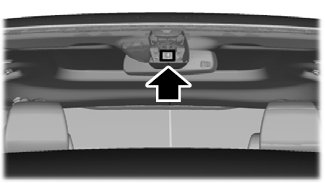Lincoln Aviator: Driving Aids / Lane Keeping System
WARNING: You are responsible for controlling your vehicle at all times. The system is designed to be an aid and does not relieve you of your responsibility to drive with due care and attention. Failure to follow this instruction could result in the loss of control of your vehicle, personal injury or death.
WARNING: Always drive with due care and attention when using and operating the controls and features on your vehicle.
WARNING: In cold and severe weather conditions the system may not function. Rain, snow and spray can all limit sensor performance.
WARNING: Large contrasts in outside lighting can limit sensor performance.
WARNING: The system will not operate if the sensor cannot track the road lane markings.
WARNING: The sensor may incorrectly track lane markings as other structures or objects. This can result in a false or missed warning.
WARNING: The system may not operate properly if the sensor is blocked. Keep the windshield free from obstruction.
WARNING: If damage occurs in the immediate area surrounding the sensor, have your vehicle checked as soon as possible.
WARNING: The system may not correctly operate if your vehicle is fitted with a suspension kit not approved by us.
Note: The system works above 40 mph (64 km/h).
Note: The system works as long as the camera can detect one lane marking.
Note: When you select Aid or Alert and Aid mode and the system detects no steering activity for a short period, the system alerts you to put your hands on the steering wheel. The system may detect a light grip or touch on the steering wheel as hands off driving.
Note: The system may not function if the camera is blocked, or if the windshield is damaged or dirty.

When you switch the system on and it detects an unintentional drift out of your lane is likely to occur, the system notifies or assists you to stay in your lane through the steering system and information display. In Alert mode, the system provides a warning by vibrating the steering wheel. In Aid mode, the system provides steering assistance by gently counter steering your vehicle back into the lane.
When the system is functioning in the combined Alert and Aid mode, the system first provides steering assistance by gently counter steering your vehicle back into the lane, followed by a warning that vibrates the steering wheel if the vehicle is still out of the lane markings.
 Using Driver Alert
Using Driver Alert
Switching the System On and Off
Switch the system on or off using the
information display.
When active, the system monitors your
alertness level based upon your driving
behavior in relation to the lane markings, and
other factors...
 Switching the System On and Off
Switching the System On and Off
Note: The on or off setting is stored until it
is manually changed, unless a MyKey is
detected. If the system detects a MyKey, it
defaults to on and the mode sets to Alert...
Other information:
Lincoln Aviator 2020-2025 Service Manual: Removal and Installation - Upper Arm
Special Tool(s) / General Equipment Vehicle/Axle Stands Removal NOTICE: Suspension fasteners are critical parts that affect the performance of vital components and systems. Failure of these fasteners may result in major service expense...
Lincoln Aviator 2020-2025 Service Manual: Diagnosis and Testing - Diagnostic Strategy
Overview The diagnostic process for each transmission concern will vary depending on the symptoms and condition of the vehicle. The diagnostic process below is an efficient method to collect as much data as possible about the concern before performing a repair or removing the transmission from the vehicle for teardown and further inspection...
Categories
- Manuals Home
- Lincoln Aviator Owners Manual
- Lincoln Aviator Service Manual
- Disabling Auto-Start-Stop
- Wireless Accessory Charger (If Equipped)
- Body and Paint
- New on site
- Most important about car
Seatbelt Height Adjustment
WARNING: Position the seatbelt height adjuster so that the seatbelt rests across the middle of your shoulder. Failure to adjust the seatbelt correctly could reduce its effectiveness and increase the risk of injury in a crash.
Adjust the height of the shoulder belt so the belt rests across the middle of your shoulder. Slide the adjuster up to raise the belt. Press the button and slide it down to lower the belt.